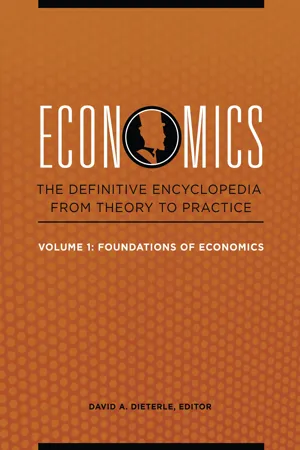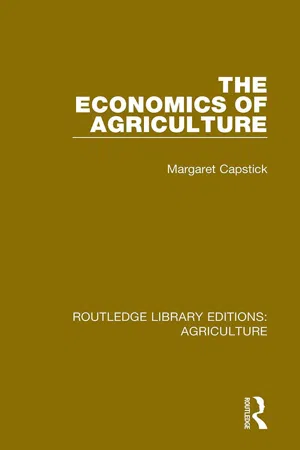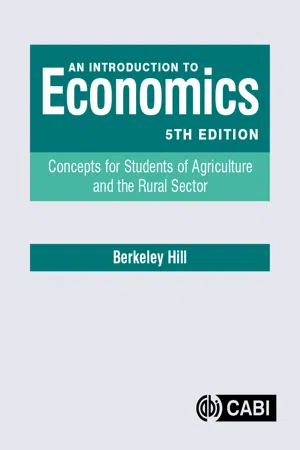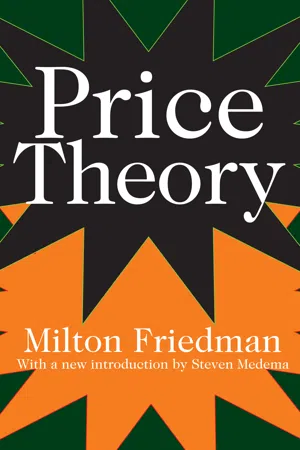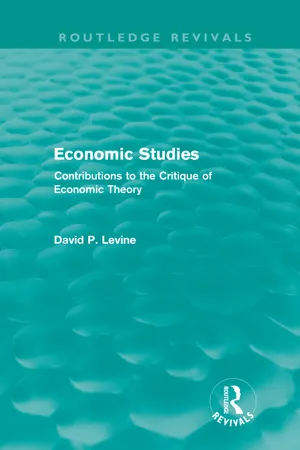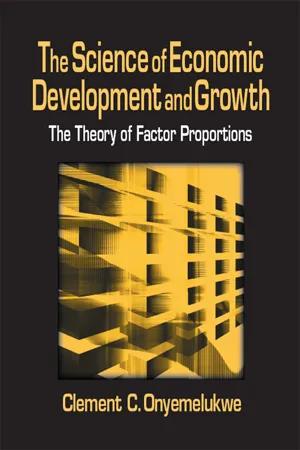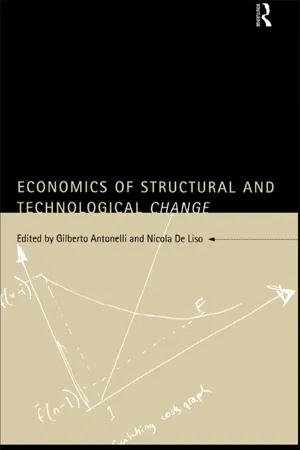Economics
Factors of Production
Factors of production are the resources used in the production of goods and services. They include land, labor, capital, and entrepreneurship. Land refers to natural resources, labor is the human effort involved in production, capital encompasses man-made tools and equipment, and entrepreneurship involves the organization and risk-taking necessary to bring the other factors together.
Written by Perlego with AI-assistance
Related key terms
Related key terms
1 of 4
Related key terms
1 of 3
11 Key excerpts on "Factors of Production"
- eBook - ePub
Economics
The Definitive Encyclopedia from Theory to Practice [4 volumes]
- David A. Dieterle, David A. Dieterle, David A. Dieterle(Authors)
- 2017(Publication Date)
- Greenwood(Publisher)
F Factors of ProductionFactors of Production are resources used to produce goods or services, and they are often called productive resources. The three main Factors of Production are natural resources, human resources, and capital goods. Some economists list entrepreneurship as a fourth factor of production. At the microeconomic level, firms use the Factors of Production to produce goods efficiently and profitably. At the macroeconomic level, national output, employment, and sustainable economic development are heavily dependent on the efficient use of society’s productive resources. The Factors of Production are unevenly distributed in the global economy.Natural resources are the gifts of nature used in production. Natural resources include minerals such as bauxite, uranium, and nickel; primary energy sources such as oil, natural gas, and coal; water bodies such as oceans, rivers, and lakes; wildlife such as animals, fish, and insects; natural vegetation such as forests and plants; and naturally occurring forces such as wind and sunlight. Natural resources provide many of the raw materials needed to produce goods and services. Some nations, such as the United States, are well-endowed with a wide variety of such natural resources as mineral deposits, navigable rivers, and arable land. Other nations may be rich in a single resource, such as oil or timber. Still others lack essential natural resources. Resource-poor Japan acquires natural resources through international trade and foreign direct investment, but poorer, land-locked countries have limited access to essential natural resources.Human resources are people who are engaged in production. Human resources include assembly line workers, miners, and contractors in the goods-producing sector; teachers, doctors, and engineers in the services-producing sector; and farmers, loggers, and ranchers in the agricultural sector. Education, training, apprenticeships, and other investments in human resources create a skilled workforce, often referred to as human capital. Human capital development increases the productivity of labor. The advanced economies finance comprehensive public education, and they support higher education and worker training programs to create human capital. The emerging market and developing countries value human capital, but they have fewer resources to support its development. In addition, the dearth of financial incentives, uncertain property rights, and low quality of life contribute to a “brain drain” in many poorer countries. This brain drain - eBook - ePub
- Margaret Capstick(Author)
- 2019(Publication Date)
- Routledge(Publisher)
CHAPTER II The Factors of Production in AgricultureThe classical economists differentiated three Factors of Production: land, labour and capital. These are still convenient headings under which to discuss the inputs in agricultural production; their relative proportions change spatially and temporally, and the use made of any one of them is dependent on the available quantities of the others, as well as on the general conditions of demand for agricultural products.Problems of Factor Allocation
Suppose that a farm or a parcel of land is offered for sale. The neighbouring farmers, as well as possible buyers from a distance, will cast their eyes on it, and assess its possible value to them in the light of their command of the other two Factors of Production, labour and capital. Will they be able to work it with their existing machinery? If it was added to their present holding, would the existing farm buildings suffice to house the increased head of stock that the joint holding would carry? Or would a new set of buildings be needed, and how much would these cost? Would their financial assets extend to buying enough livestock to make full use of the extra land; or would it be better to put some of the newly acquired acres into arable, which needs less immediate capital outlay? Would the present labour force be able to cope with the extra work with existing plant; for example, would the present milking parlour be adequate for the milking of a bigger dairy herd with the present labour, or should there be two men to milk, or a parlour of a different design in which the present one cowman could milk the extra cows (in other words, could the productivity of present labour be increased)? Such questions show that one factor of production can rarely be considered in isolation; changes in one factor must be considered in the light of the availability of one or both of the other factors.This first set of questions concerns the balance of factors. At any one time, with given technology and given prices of inputs and of output, there will be one possible combination of factor inputs, either into an existing farm business or into a potentially expanded business which will be, for that business, the optimum combination or ‘bundle’; this combination will produce the greatest possible margin of revenue over costs. With optimal factor allocation, the marginal product of each factor will be equal. - eBook - ePub
An Introduction to Economics
Concepts for Students of Agriculture and the Rural Sector
- Berkeley Hill(Author)
- 2021(Publication Date)
- CAB International(Publisher)
Chapter 8 ).Classification of Factors of ProductionAll production processes, whether of the self-sufficient sort or the product-exchange sort, involve taking a collection of inputs (for milk production these would include animal feed, water, labour for milking and stock care, land to grow fodder, buildings and equipment, and management skills) and combining them in some way, resulting in an output, or product. In our example we have several products – as well as milk, which is the primary product, calves and dung are by-products. It is generally agreed that the inputs to production processes can be classified into four broad groups of Factors of Production: (i) land; (ii) capital; (iii) labour; and (iv) entrepreneurship.Each main group of Factors of Production is considered separately in this chapter. Almost all production processes involve all four. Knocking a crab apple off a wild tree with a stick is a very simple process, but all four types of factor are present. The earth’s resources (land) have produced the apple, the stick is a piece of capital, labour was involved in using the stick, and the decision to pick the apple was an entrepreneurial one.Land as a Factor of ProductionLand as a factor of production has a particular importance for agriculture because, compared with other industries, farming requires a lot of it. According to OECD statistics in the UK, agriculture (excluding forestry) takes up about three-quarters of the total land area (rather more than the 51% for the EU as a whole) but it only engages about 1.0% of the UK working population (3.7% in the EU). Just as we describe a firm which needs a high proportion of labour in its mixture of inputs (such as thatching, or any craft work where mechanization is impossible) as labour-intensive, so we should label agriculture as land-intensive when comparing it to most other industries. - eBook - ePub
- Milton Friedman(Author)
- 2017(Publication Date)
- Routledge(Publisher)
11The Supply of Factors of ProductionThe Factors of Production
Our discussion of demand for Factors of Production was in highly abstract terms; we did not consider the specific character of the Factors of Production or give them names. The reason is that on the demand side, there seems no empirical classification of factors that has such special importance as to deserve being singled out; the classification that is useful will vary from problem to problem. On the demand side, the chief consideration in classifying factors is substitution in production. A single factor consists of units that are regarded as perfect substitutes in production; different factors consist of units that are not perfect substitutes. For some problems, it will be desirable to separate out many different Factors of Production; for others, only a few.It has traditionally been supposed that conditions of supply give a more substantial and empirically significant basis for distinguishing among Factors of Production in specific terms. The classical economists distinguished three main Factors of Production: land, capital, and labor. Land they regarded as a permanent, nonreproducible resource fixed in amount, the supply of which was therefore perfectly inelastic to the economy as a whole. Capital they regarded as a reproducible resource, the amount of which could be altered through deliberate productive action, so its supply was not perfectly inelastic. Indeed, in the main, they tended to regard it as highly elastic. Labor, like capital, they regarded as reproducible and expansible, and, indeed, as supplied to the economy in the long-run at constant cost, yet to be distinguished from capital because of its dual status as a productive resource and an ultimate consumer. - eBook - ePub
- Gary Becker(Author)
- 2017(Publication Date)
- Routledge(Publisher)
PART FOUR Supply of Factors of ProductionPassage contains an image
chapter 9 Human Capital
LECTURE 32
Land, Labor, and Capital
We have only casually discussed the determinants of the quantity supplied of different Factors of Production to an economy or to its various subdivisions. The supply of factors is one of the most difficult and unsettled topics in economic theory although progress has been rapid during the last 15 years. Consequently, our lectures on factor supply will be closer to the frontier of current research than were the lectures on the supply and demand of final products, production functions, and derived factor demand because these topics have been better worked out for a longer period.The classical economists presumed three basic Factors of Production: land, labor, and capital (called the “holy trilogy of economics” by Frank Knight) according to their presumed supply responses to prices. Land was assumed to be endowed by “nature” with “original and indestructible properties” (to use David Ricardo’s term) that were unresponsive to changes in the price of land. The supply of labor, on the other hand, was assumed to be regulated by the forces of misery, vice, and virtue. If wage rates rose above the “ subsistence” level, the supply of labor would readily increase both because births would be increased by earlier marriages and less abstinence while married and because deaths from disease and starvation would decrease. The elasticity of labor was, therefore, presumed to be high. The elasticity of the supply of physical capital was considered to be between those of labor and land although closer to the former.These distinctions were not valid even in the nineteenth century, and today they are extremely misleading. Although the physical size of the earth has been fixed and indestructible (trips to outer space have begun to change this!), the economic supply of land has been greatly changed by man’s efforts. For example, much of the land in the Netherlands was under water a few hundred years ago and became available only through large-scale drainage programs. Similarly, irrigation programs have greatly increased the agricultural land in Israel and other dry parts of the world. Mankind has also cleared forests, drilled oil wells on the bottoms of seas, built tall buildings, and so forth. Economists now recognize these developments by treating land simply as a “produced” durable factor of production, that is, as one kind of capital. - eBook - ePub
Economic Lessons from the Transition: The Basic Theory Re-examined
The Basic Theory Re-examined
- Daniel R. Kazmer, Michele Konrad(Authors)
- 2016(Publication Date)
- Routledge(Publisher)
3 The Factors of ProductionHow Incomes Are Determined
Factors are the inputs into the production process. Traditionally, theory deals with three general categories. Land—including timber, fisheries, and other natural resources—earns rents. Labor earns wages. Capital—meaning here plant and equipment, not money—earns profits. These factors combine to make every product and service sold on the market.But how much are these factors worth, and who or what determines the income paid to the factor owners? Historically, this question has been answered both by political theory (capitalism, Marxism-Leninism, socialism) and by economic theory. We will first discuss economic theory, although the political theory relating to factor incomes is also interesting and important.Economic theory has developed an elegant and optimal determination of factor incomes, the theory of perfect competition. It applies the same marginal optimizing rules to factor markets that it applies to product markets.As in product markets, each factor will be paid the contribution of its marginal product to marginal revenue. Thus, if the last worker hired adds one-tenth of a widget per hour to total output and that last widget sold adds 10 euro to total revenue, then all workers will be paid the value of their marginal revenue product or 10 euro X 1/10 widgets = 1 euro/hour.Economic theory then proves that a competitive economy will make optimal use of its factors, from inputs to production, since each factor will move to the productive activity at which it is paid the most, that is, where the value of its marginal revenue product is highest. They will stop moving and be at equilibrium when the values of all their marginal revenue products are equal—when output can no longer be increased by moving inputs around. - I.R. Bowler(Author)
- 2014(Publication Date)
- Routledge(Publisher)
Empirical analyses rarely contradict the general thrust of these points, although they regularly demonstrate the importance of local circumstances in the explanation of geographical patterns. Farming areas continue to reflect the influence of their histories, cultures and natural environments, with all of these contributing to regional differences in farm size and systems of agricultural production, and therefore to particular combinations of resource use. This observation has been confirmed in Fitzsimmons’s (1986) study of agriculture in California, and in Gilbert and Akor’s (1988) comparison of milk production in Wisconsin and California. Individual farmers and their families respond in a multitude of ways to external pressures, partly out of choice and partly out of necessity. Much depends on their ability to raise capital, their attitude to land purchase, their family structure and their ability to obtain offfarm employment.Some general considerations
Factors of Production may be defined as those ingredients necessary to the production process. Traditionally, they have been recognized as land, labour and capitaL although the forms each may take vary considerably. On occasion, a fourth factor - enterprise - has been separately identified in order to encapsulate the risk-bearing and management functions of the entrepreneur. Enterprise will not be examined separately here. One reason for this is the increasingly complex ways in which managerial tasks and responsibilities arc distributed among family members, farm managers and even hired workers on large farms, and in a further sense may be said to be divided between farmers, advisers and even the managerial staff of the co-operatives to which many belong. Another is the inevitable mixing of manual and management activities on farms run by sole operators.The three remaining Factors of Production are always employed in combination, even if the manner in which they are combined and the relative importance of each differs markedly between farming systems. Indeed, these differences contribute to the debate as to whether agriculture can be sensibly seen as a single industry. Extremes are illustrated in the livestock sector. In the case of farms specializing in intensive, housed livestock production, land is merely a condition of production (see p. 13), providing a site upon which buildings may be constructed and to which large quantities of working capital and labour are applied and feeding-stuffs may be brought. In the case of extensive grazing systems, very small amounts of labour and capital are applied per unit area, often to large areas of poor land realizing low forage yields, but upon which the livestock may be wholly dependent.- eBook - ePub
Economic Studies (Routledge Revivals)
Contributions to the Critique of Economic Theory
- David Levine(Author)
- 2013(Publication Date)
- Routledge(Publisher)
But it is possible to go one step farther and consider the meaningfulness, in a general sense, of the idea of fixed factors and therefore the rationale for eliminating them altogether from economic analysis. It is instructive, in so doing, to start with a treatment of the idea of labor as a factor of production since, even in the light of the weaknesses of the treatment of capital within the neo-classical theory of production, the idea of a factor of production is retained without question in the case of labor and land. It has even been argued that the idea of a labor theory of value is ultimately based on the idea of labor as the sole primary factor of production. From the point of view of economic analysis it is equally pertinent to question the status and meaning of labor as it is to question that of capital, the issues are, in fact, intimately connected. Does the impossibility of determining the quantity of capital independently of its value also extend to the determination of a quantity of labor? The answer to this question is that in one sense it does raise important questions concerning the concept of labor. It must be emphasized from the outset, however, that it does not do so with respect to the possibility of measuring or aggregating labor in general, but only in terms of the method of measurement which implicitly underlies the idea of labor as a factor of production. The point, to anticipate the results of this discussion, is that the problem is not one of uncovering ‘native’ or ‘natural’ measures for economic variables. In so far as the attempt is made to find a natural measure of the inputs into production the analysis must remain within the confines of the ‘factor of production’ viewpoint - eBook - ePub
The Science of Economic Development and Growth: The Theory of Factor Proportions
The Theory of Factor Proportions
- C.C. Onyemelukwe(Author)
- 2016(Publication Date)
- Routledge(Publisher)
Conventional economics has aggregated capital in terms of dollar values. In doing this, it treats capital as “a produced factor of production,” in line with the incorrect claim that capital is sacrificed consumption. They could not provide a theoretical framework for evaluating capital in terms of factor inputs. It therefore approximates this product as the total dollar value of capital goods. This is an empirical solution and not natural (scientific). This financial evaluation means that the total dollar value ascribed to capital comprises other costs that do not form part of a technical factor input into the capital good production, such as rents, transport, and other financial overheads. On the other hand, we have correctly treated capital as the accumulation in an economy over time of labor and material diverted from the overall supply for capital formation. The determination of the price of labor in the United States, for example, is characterized by market imperfections. Labor markets in the United States are a blend of competition and monopoly elements. The level of wages is determined by factors that do not depend directly on the size of the labor supply. Different levels of labor earn different wages.The price of raw materials depends on many factors—including the cost of extracting the resource and the demand. In high-cost oil fields, the cost of crude oil is high because of high exploration and extraction costs. If the demand for crude oil is high, this immediately sends crude oil prices climbing. When the demand is low due to a spell of warm weather in Western countries, the price of crude drops. In some instances prices rise even when there is an oil glut. Material supply is usually dominated by a lot of monopolistic practices. Many times politics plays more part in the availability and price of particular resources than supply and demand.All in all, prices are not a good indicator of the relative factor endowments of an economy. It follows that theories of factor utilization based on prices will divert economics from the requirements of economic science. Prices are the shadow. The factors and their efficient use are the substance. A shadow is often not a true reflection of the substance and may in fact distort it. - eBook - ePub
- Wilhelm Roscher(Author)
- 2009(Publication Date)
- Perlego(Publisher)
Book I.The Production Of Goods.
Chapter I.
Factors of Production.
Section XXX.
Meaning Of Production.
To create new matter is more than it is given to man to do. Hence, by the term production, in its widest sense, we mean simply the bringing forth of new goods—the discovery of new utilities, the change or transformation of already existing goods into new utilities,184 the creation of means for the satisfaction of human wants, out of the aggregate of matter originally present in the world. (Producere! ) We confine ourselves, however, in this to economic goods, as defined in § 2 . In a secondary and more limited sense, production is an increase of resources, in so far as the goods produced satisfy a greater human want, than those employed in the production itself.185 186 187[pg 120]It would, however, be an error to suppose, that the creation of certain utilities for the producer himself, or for others, constitutes the only end of economic production. The more perfect economic production becomes, the greater grows the pleasure the producer feels in his products, which pleasure is at once the effect and the cause of his success. Hence, production is to a great extent its own end. That this is so in the case of artists is well known. “If you want only progeny from her, a mortal can beget them as well. Let him who rejoices in the goddess, not seek in her the woman,” says Schiller. There is not a really clever workman but has something artistic in his mode of production. And even the meanest productive activity, provided it is neither over-driven nor misdirected, must of itself exert a good influence on the physical and moral development or preservation of the producer. An idle brain is the devil's workshop.188Section XXXI.
The Factors of Production.—External Nature. 189
The division of natural forces which formerly obtained, into organic, chemical and mechanical, is of no great importance in Political Economy. The tendency is more and more to resolve organic forces partly into chemical and partly into mechanical. Between mechanical and chemical forces, again, the boundary is not fixed, heat being always capable of producing motion, and motion always of producing heat. Hence, it is all the more important for us to find a division of the economic gifts (matter, forces190 and relations) of external nature, into such [pg 121] as are capable of acquiring exchange value, and such as are not. (See § 5 - eBook - ePub
- Cristiano Antonelli, Nicola De Liso(Authors)
- 2002(Publication Date)
- Routledge(Publisher)
- At the definition level, connections between technology, natural and environmental resources and the combination of individual working tasks into functions are pretty strong. The notion of input itself depends on both knowledge and technological diffusion, as well as on the degree of scarcity.
- Economic literature has favoured, at least in the past, a treatment of these broad factors as if they were ‘black boxes’. The prevailing approach dealt mainly with the study of the effects of exogenously given phenomena, concerning the single factors. Instead, it would be better to use an approach where the demarcation of the research field, even if sharply needed from an analytical point of view, is based on a preliminary investigation of the real phenomena crucially affecting the theoretical assumptions.
- Analyses have often shown how important the stocks of broad production factors are when we aim at studying the input flows and at exploring the boundaries between private costs/benefits and social costs/benefits, associated to the productive use of broad production factors (Kapp, 1963).
- Finally, the broad production factors and their interactions seem to play an important role in the identification of ‘technological systems’,7 understood as networks connecting production factors, sectors and techniques; they also underline the weight of relative proportions and institutional factors either when different economic systems are compared or in the analysis of adjustment processes.
2 THE DYNAMIC NATURE OF PRODUCTION FACTORS UNDER CONTINUOUS TECHNOLOGICAL CHANGE: THE CONTRIBUTION OF THREE SPECIFIC PERSPECTIVES OF ANALYSIS
Looking at the recent evolution of economic thought on the three broad production factors outlined in the first section, it is possible to point out a meaningful analogy. In every perspective of analysis the distinction between two different generations of studies is evident. And this distinction embraces both the core of theoretical analysis and applied research. Such a distinction is due to the inward evolution of economic theory, but especially to the need of explaining new real phenomena, of studying institutional and structural ‘anomalies’ taking place in the course of economic growth. This, of course, might imply the necessity of abandoning a systemic outlook or giving up the steady state equilibrium configurations.
Index pages curate the most relevant extracts from our library of academic textbooks. They’ve been created using an in-house natural language model (NLM), each adding context and meaning to key research topics.
Explore more topic indexes
Explore more topic indexes
1 of 6
Explore more topic indexes
1 of 4
